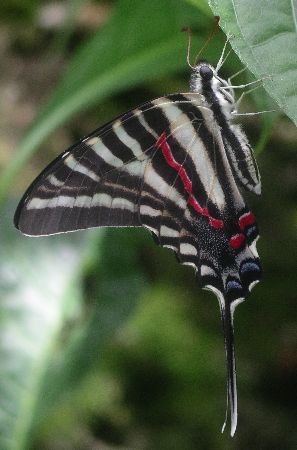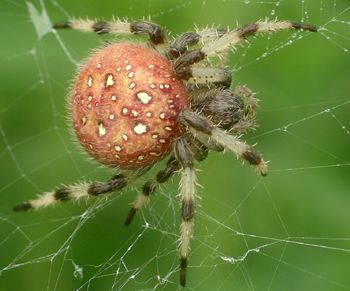
Fairly common in Florida, the lovely Zebra Swallowtail does not occur in Austin.
 Fairly common in Florida, the lovely Zebra Swallowtail does not occur in Austin. |
So with the multitude of creatures here, I should be perfectly satisfied with finding an endless array of wee beasts in my own backyard. But when the chance to explore a different area of the country comes up, I can't wait to go! This is the "Grass is Always Greener" phenomenon (GAG). Suddenly, the numbers don't matter; just the fact that there are animals that I cannot see HERE but might find THERE.
Florida and Wisconsin are two places that I get to visit occasionally, because I have relatives living in those states. Both of these locations are delightfully different from Texas and common species in those areas might be new subjects for my camera. For an avid taxonomist, it is pure bliss. An animal might be unique to one of these locales (an endemic) and found nowhere else. These are a real prize. The chance of finding something like that on a one or two day visit to some far away place is small, but it happens more often than might be imagined, especially with insects.
If one does one's homework ahead of time, she or he will already know what species to be alert for. But even without any preplanned agenda, it can be very rewarding to simply pay attention to anything that looks out of the ordinary. I chanced upon an odd little black butterfly while at Fairchild Gardens in Miami. It kept landing on cycads and, after a 20 minute chase that was at times quite exasperating, I managed to take a photo of it. Later I found out that it was an endemic species, the Atala, which lives only in that small area and actually uses cycads as the host plant for its caterpillars.
More frequently found are animals that are common but might not occur around our home base. Although mountainous areas in Colorado are not really renowned for insect diversity, there are a few specialties that can be found there and certainly not here in our very different climate. One such beast that I encountered a few years ago was the Mormon cricket. As it is a well-known bug, I had of course heard of these large katydids, but had never seen one. On a hike in the mountains of southwestern Colorado, these impressive insects were suddenly quite abundant in my vicinity and easily photographed. Another prize photographic "catch" was a White Admiral up in Wisconsin. The northern range of that butterfly assures that I will never happen upon one here in Texas.
 Although the Shamrock Spider can be seen in much of North America, including Wisconsin, where this photo was taken, this arachnid is not found in Texas. |
While there are plenty of animals that are found across wide expanses of the country, those that are localized seem just a bit more special. From manatees in Florida, peccaries in Big Bend, and trumpeter swans in Wisconsin to the tiny spiders and insects that are also part of the native fauna of each region, animals help define the location. They provide that "sense of place," giving each area a little value-added uniqueness.
So is the grass always greener on the other side of the fence? No, but it is often different, and, to quote another cliché, variety is the spice of life.